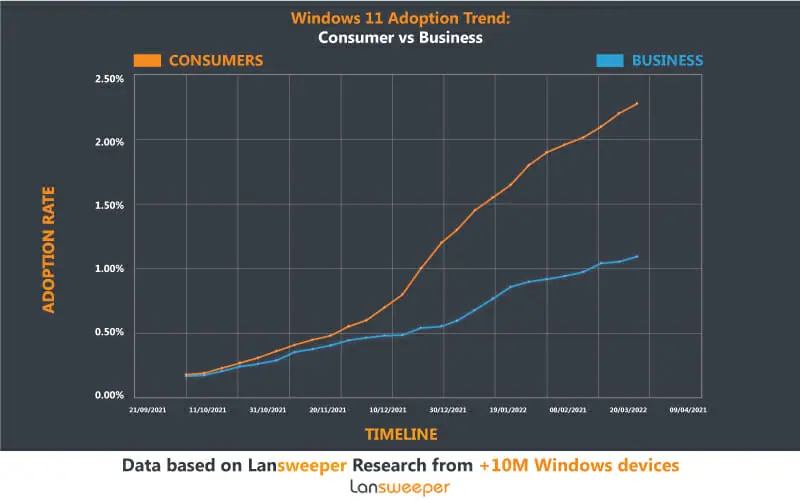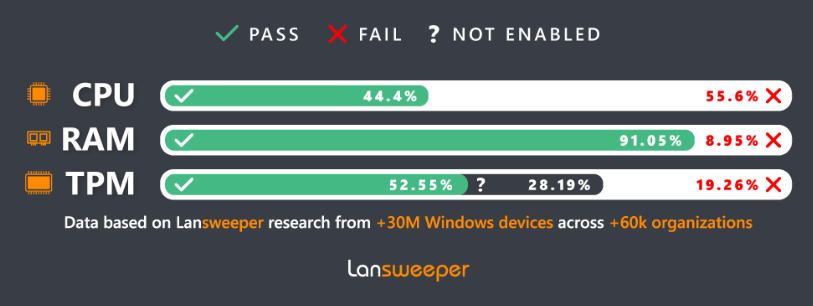| Windows 11's Shockingly Low Adoption |
| Written by Janet Swift | |||
| Wednesday, 20 April 2022 | |||
|
It is over six months since Windows 11 launched. So how is it doing? According to recent figures it is on fewer than 1.5% of Windows desktop machines, which means that is less popular than Windows XP which is still on 1.7% of desktops more than 7 years after its end of life. This chart, showing the position in April 2022, comes from Lansweeper, an IT management provider, which used its proprietary software to scan more than 10 Million Windows devices to determine which version of Windows they were using. LanSweeper has also charted the rate of adoption of Windows 11 by businesses compared to Individuals, finding that businesses are only half as likely to have upgraded to Windows 11. Looking back at introduction of Windows 10 at the end of July 2015, the new operating system already had a 5.21% global share of the desktop market by the end of the first month, 6.63% by the end of the second month and 7.94% at the end of the third month (October). By the end of April 2016 (9th month) this share stood at 15.34%. These percentages were based on charts and data from NetMarketShare which included MacOS, and Others (predominantly Linux) in its analysis. The charts from Lansweeper only relates to versions of Windows and so the old figures need to be inflated by around 10% to account for this difference. At the time we were surprised at the slow pace of Windows 10 market penetration - especially as Micorosoft offered it as a free upgrade to a large proportion of Windows user. Indeed, at its launch Microsoft's Terry Myerson had made the ambitious prediction that it would be on 1 Billion Devices in two to three years. In fact it took almost 5 years for that milestone to be reached. Many people, myself included, imagined that upgrading to Windows 10 was a final step along the Windows road. Microsoft had promised that 10 was the last version of Windows. So the announcement of Windows 11 caught us by surprise - and not a nice surprise when we learned of its hardware requirements and the fact that Microsoft also insists on users having a Microsoft account. The extent to which this stipulation might be a deterrent to upgrading is explained in Windows 11 The Lockdown. At first Microsoft stated that Windows 11 would only run on specific processors. Even though this seems to have relaxed a bit would-be users still have to have a lot of kit:
Given this spec for most users upgrading to Windows 11 would be most easily achieved by buying a complete new system with the operating thrown in as part of the deal. Throwing out perfectly good hardware isn't an option that many Windows users are prepared to take so Lansweeper set out to discover what proportion of existing hardware met the system requirements for upgrading to Windows 11. Based on an estimated 30 million Windows devices from 60,000 organizations its findings revealed that on average, only 44.4% of the workstations were eligible to receive the automatic upgrade, while the rest would be ineligible. In view of these findings perhaps it isn't surprising that take up of Windows 11 is so low. Other research backs up the idea that the hardware requirements is having a depressing effect on Windows 11's adoption. The latest monthly Steam survey from Valve, of gamers who typically have the latest and fastest hardware, puts Windows 11 usage at 16.8%. More InformationUpdate on Windows 11 minimum system requirements Related ArticlesTo be informed about new articles on I Programmer, sign up for our weekly newsletter, subscribe to the RSS feed and follow us on Facebook or Linkedin.
Comments
or email your comment to: comments@i-programmer.info |
|||
| Last Updated ( Wednesday, 20 April 2022 ) |





